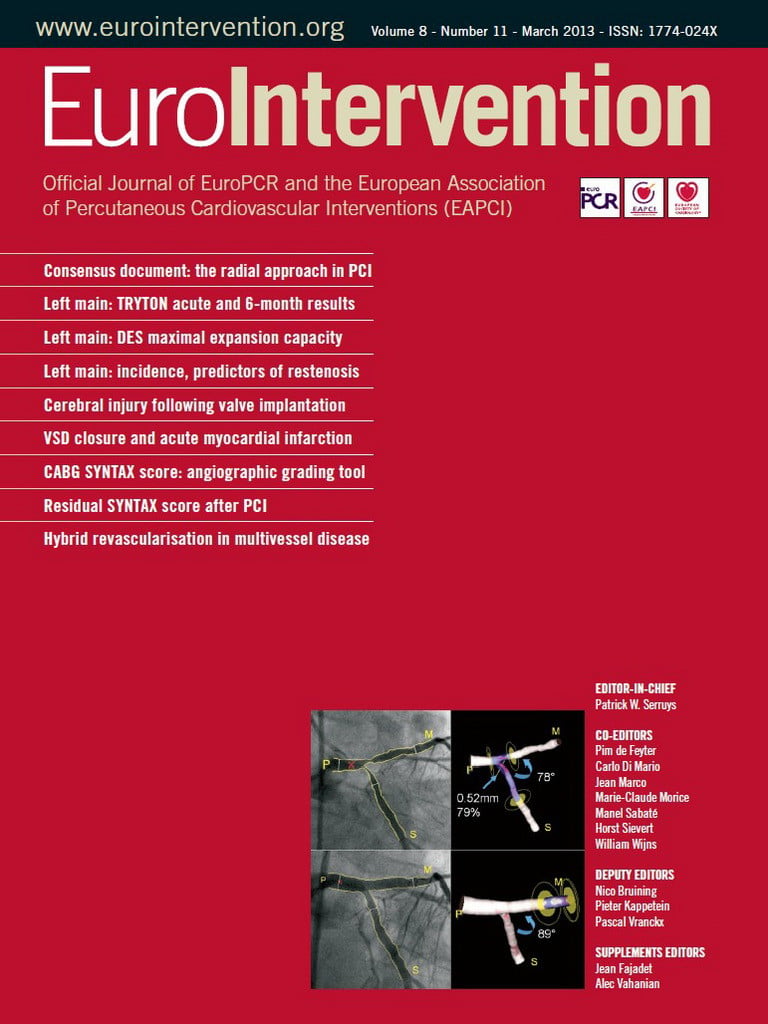In this month’s EuroIntervention we continue our successful trend of “cluster publishing”, choosing to group a series of papers on specific topics of interest such as – in this month – left main interventional therapies, the SYNTAX score and structural heart disease. However, before we look at these articles, I would like to begin by drawing your attention to another paper of consequence that you will find printed in this issue.
The “Consensus document on the radial approach in percutaneous cardiovascular interventions: position paper by the European Association of Percutaneous Cardiovascular Interventions and Working Groups on Acute Cardiac Care and Thrombosis of the European Society of Cardiology” is not only important for authors, clinicians and other interested readers, but also for EuroIntervention itself1. This consensus document represents the continuation of a publishing trend, and our Board is actively pursuing publications of this nature and quality. Naturally, we recognise that consensus or guidelines documents for the general cardiologist are better placed in cardiology journals such as the European Heart Journal; still, the more specialised or technical documents in interventional medicine will be submitted to EuroIntervention where they have a clear path to target directly their most appropriate audience. It is at this juncture that I would like to acknowledge personally the EAPCI for their positive support for our journal with respect to this current consensus publication, as well as for future consensus/guidelines documents.
An interesting aspect of this document is that it was first published online as an “EEP” (EuroIntervention Expedited Editorial Publication). This type of publication strategy, reserved for papers of timely and topical interest, allows papers to be prepared and processed for publication very quickly. This particular EEP was accompanied by an e-blast, an e-mail announcement that reached approximately 30,000 readers from our database. A single EuroIntervention tweet was also sent out regarding this paper which reached 4,526 twitter accounts. Within the first 24 hours after publication the resulting usage data generated –the website views and PDF downloads– was impressive: 3,231 pages viewed, 627 PDFs and 158 slide sets downloaded from our dedicated website. These slide sets of published papers are, by the way, a relatively new feature, freely available to EuroIntervention readers.
It is interesting to bear in mind these numbers when considering the relative “sensitivities” of evaluating our journal through the all-important “impact factor”. We have discussed this before: valid as the impact factor may be and despite the fact that it was also developed almost 60 years ago, it does not take into account all this usage/online data, a fact which further testifies to the vitality of our new modern methods of information dissemination.
Continuing with other articles in the current journal, we see several papers reporting on bifurcation disease, a discipline which moves at its own quiet pace. Having concluded the SYNTAX cycle with two recent publications in the Lancet, we now start a new cycle presenting the EXCEL study, in which 2,600 left main patients with a SYNTAX score of <33 will be randomised. Gregg Stone, Joseph Sabik, A. Pieter Kappetein and myself are principal investigators. Noteworthy here is that the SYNTAX score classification of <33 was requested by the FDA, suggesting that they have adopted our classification of the SYNTAX score as inclusion and exclusion criteria for FDA approved trials such as SURTAVI and PIVOTAL US. Furthermore, the FDA strongly advises against studies with SYNTAX scores above 33.
I have always said that the most accessible and widest bifurcation is the main stem. Unfortunately, many of the dedicated bifurcation stents have been studied in small peripheral coronary arteries, mostly distal to the guide catheter. Against this background, it is interesting to consider the dedicated bifurcation stent in the main stem focused on and presented in one of our later articles in the current issue.
Cerebral injury following valve replacement will remain a topic of great interest for the next five to seven years as it may be the result of an embolic issue or perhaps the result of a thrombotic phenomenon on the valve. It is clear, therefore, that the whole conundrum of thrombus on the valve, embolism during the procedure and transient atrial fibrillation post-procedure needs to be resolved. Certainly pharmacological therapies and embolic filters will play an important role here.
I am not in favour of the “SYNTAXmania” (an expression coined by Martin Leon); people have to understand that this is not a chaotic explosion of different scores, it is a streamlining and improvement of the score as applied to different situations and timing –for instance stable versus unstable syndromes, pre- and post- surgery, pre- and post- PCI. In the present issue, for the first time, we have a post-CABG SYNTAX score developed after frequent “real world” requests on how to address this issue, and on this subject we publish a modest proposal from the SYNTAX score group.
Finally we conclude with a paper (read the excellent editorial by David P. Taggart that follows) illustrating the fact that beyond the Heart Team there is incidental room for a combination of surgery and PCI…in the same patient.
Reference

